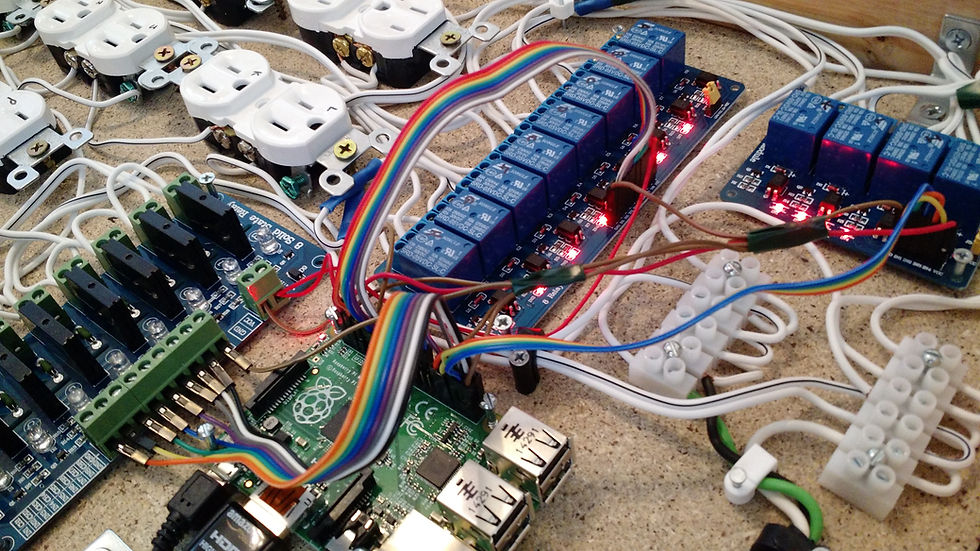Raspberry Pi On IOT
- Debjoyti Louha
- May 14, 2021
- 4 min read

Raspberry Pi is a great platform to learn about IoT, but it's not the only one to develop projects in the Internet of Things. In this article we will learn how to recognize exactly what the Raspberry Pi needs to do to connect IoT devices, and how to prevent the Pi from doing something else. The following list contains a list of over 30 repositories that deal with IoT-related projects, using a variety of tools and tools available in the open source community. Hacks in the IoT space that we hope we can tackle, as well as some of the more interesting and interesting projects out there. [Sources: 8, 9, 11]
Many of them are stupid, some ambitious and many of them are finished, but it is very valuable to learn about the Raspberry Pi as a common component of the IoT. This article introduces a script that allows you to embed the Raspberry Pi into any IoT device using an IoT solution. In this article we will go through the basics of using the Pi in a commercial environment. [Sources: 9, 11, 13]
This tutorial assumes that the Raspberry Pi has an active connection to the Internet, so that we can connect to the Cumulocity IoT server. This tutorial describes how to install the CumULocity Iot agent and the corresponding drivers on the Raspberry Pi, which is necessary to remotely manage the connected devices that can be connected to it. We use it as the host URL to define the host of the URL, and if the Aspberry Pi is near the server, it listens to that port. [Sources: 11, 12]
You should also learn about Arduino, Raspberry Pi, cameras and robotics before you start working on this project. There is also a secondary I2C port, which primarily facilitates the use of the GPIO port of the Aspberry Pi and its GPIO controller, which can be connected directly to the Raspberry Pi. If you use a Model B, this applies to both the RaspberryPi and Model B. [Sources: 0, 3, 14]
Insert the memory card into the Raspberry Pi and follow the instructions to flash the Raspberry Pi OS onto the microSD card. Connect to your RaspberryPi and follow the recommended software for flashing and flashing the operating system of the Aspberry Pi onto a micro SD card and connect to its GPIO port. [Sources: 2, 7]
The Raspberry Pi also has the ability to interact with external sensors via its GPIO (General - Purpose Input / Output) pins. The RPI-GPIO is equipped with a library that allows Python applications to easily access the GPIO pins of the Raspberry Pi. This essentially allows you to use Windows technology to create your own applications based on the Python programming language, such as Python 2.0, Python 3 or Python 4.1. [Sources: 4, 14]
IoT developers who are not comfortable with embedded programming should rely on the Raspberry Pi instead. IoT projects, choosing the right development location for your IoT project can offer incredible value to your business due to its ability to streamline power consumption, reduce development hours and shorten time. In fact, one of the most important aspects of using the Raspberry Pi to learn IoT is to pick the right project for the start. [Sources: 6, 9]
Typically, multiple functions are required at a given time, and when it comes to an IoT application, it would be smart to give the Raspberry Pi a task to save overall costs and make things easier. [Sources: 6, 10]
Once you have successfully completed this part of the tutorial, we have a device like the Raspberry Pi that can be connected to the Cumulocity IoT Server and viewed by a variety of applications, from a web application to a mobile application. All you have left is an application that runs on IoT Core. To get a sense of how things work, I used a selection of sample applications to see how Windows disappears. Kosmos was developed for people who use the product, which means that the application is set up and provided without coding. Those who already have the Raspberry Pi can get started with the Kosmo IoT system in a few minutes. [Sources: 4, 12, 13]
Connect the Pi to an Ethernet cable and follow the instructions to connect to a wireless network. Use an Ethernet cable or Ethernet cable to connect the Pi to your wireless networks. Follow the instructions to connect to your wired networks, such as a Wi-Fi connection or a WiFi connection on the Raspberry Pi. [Sources: 1]
The AWS IoT Device SDK for Python requires Python v3.5.0 or higher to be installed on the Raspberry, or Python 3.4.1 or higher. The AWS IoT DeviceSDK for JavaScript requires nodes, js, npm and the package manager, all of which install on your Raspberry. [Sources: 5]
This tutorial describes how to register for the Cumulocity IoT platform, download project examples and download the project example. For more information on how we set up Windows 10 IoT Core on the Raspberry Pi, visit windowsondevice.com. CumULocity's IoT Agent allows you to update the firmware of your RaspberryPi using the rpi - update tool. [Sources: 3, 12]
Sources:
[0]: https://www.upgrad.com/blog/raspberry-pi-iot-projects/
[1]: https://docs.microsoft.com/en-us/azure/iot-hub/iot-hub-raspberry-pi-kit-node-get-started
[2]: https://cloud.google.com/community/tutorials/cloud-iot-gateways-rpi?hl=it
[3]: https://www.crazypi.com/microsoft-iot-pack-for-raspberry-pi-3
[4]: https://www.windowscentral.com/how-install-windows-10-iot-raspberry-pi-3
[5]: https://docs.aws.amazon.com/iot/latest/developerguide/connecting-to-existing-device.html
[6]: https://www.soracom.io/blog/should-i-use-arduino-or-raspberry-pi-for-my-iot-project/
[7]: https://phppot.com/php/getting-started-with-iot-using-raspberry-pi-and-php/
[8]: https://www.telematika.org/post/iot-projects-with-raspberry-pi-arduino-esp8266-and-esp32/
[9]: https://www.informationweek.com/software/enterprise-applications/10-raspberry-pi-projects-for-learning-iot/d/d-id/1320757?
[10]: https://www.cisin.com/coffee-break/Enterprise/which-one-is-better-arduino-or-raspberry-pi-for-iot-app-development.html
[11]: https://developer.ibm.com/technologies/iot/articles/iot-security-pi-usage-patterns/
[12]: https://cumulocity.com/guides/device-tutorials/raspberry-pi-4/
[13]: https://blog.temboo.com/raspberry-pi-iot/
[14]: https://www.codemag.com/article/1607071/Introduction-to-IoT-Using-the-Raspberry-Pi








Comments